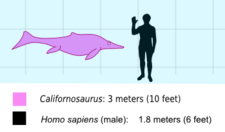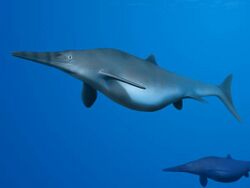Biology:Californosaurus
| Californosaurus | |
|---|---|

| |
| Holotype skeleton | |
| Scientific classification | |
| Kingdom: | |
| Phylum: | |
| Class: | |
| Subclass: | |
| Order: | |
| Suborder: | |
| Family: | †Californosauridae
|
| Genus: | †Californosaurus Kuhn, 1934
|
| Binomial name | |
| †Californosaurus perrini Kuhn, 1934
| |
| Synonyms | |
| |
Californosaurus ('California lizard') is an extinct genus of ichthyosaur, an extinct marine reptile, from the Lower Hosselkus Limestone (Carnian, Late Triassic) of California , and also the Muschelkalk (Ladinian, Middle Triassic) of Germany .[1]
Taxonomy
Merriam (1902) described it as a new species of Shastasaurus, S. perrini.[2] He later recognized the species as generically distinct from the Shastasaurus type species, erecting Delphinosaurus for S. perrini. However, Delphinosaurus had been previously used for an ophthalmosaurid from Albian-Cenomanian deposits in European Russia, and Kuhn (1934) provided the generic replacement name Californosaurus. Merriam (1938) independently erected Perrinosaurus to replace Delphinosaurus, but this is a junior objective synonym.[3][4]
Description

The long-snouted head is small in comparison with the rest of the body, as in basal ichthyosaurs such as Mixosaurus and Cymbospondylus.[5] The tail is sharply turned downwards, in common with more advanced ichthyosaurs, with a small vertical fluke. It may have had a small dorsal fin. There is a small number of pre-sacral vertebrae (45 or 50). The phalanges (digit bones) are circular and widely spaced, giving the flipper a round appearance. It was a medium-sized ichthyosaur, measuring up to 3 m (9.8 ft) long.[6]
Biology
It fed on fish and other small marine creatures. Like other ichthyosaurs it probably never ventured onto dry land, and gave birth in the water.
See also
- List of ichthyosaurs
- Timeline of ichthyosaur research
References
- ↑ von Huene, Friedrich (1916). "Beiträge zur Kenntnis der Ichthyosaurier im deutschen Muschelkalk" (in de). Palaeontographica (Tübingen) 62: 1–68. https://www.biodiversitylibrary.org/item/110906#page/13.
- ↑ Merriam, J. C. (1902). "Triassic Ichthyopterygia from California and Nevada". Bulletin of the Department of Geology of the University of California 3 (4): 63–108. https://www.biodiversitylibrary.org/item/148596#page/92/mode/2up.
- ↑ Hilton, R. P., 2003, Dinosaurs and other Mesozoic reptiles of California: University of California Press, 318pp.
- ↑ Kuhn, O., 1934. Ichthyosauria: Fossilium Catalogous, 1: Animalia, p. 1-75.
- ↑ M. W. Maisch. (2010). Phylogeny, systematics, and origin of the Ichthyosauria - the state of the art. Palaeodiversity 3:151-214
- ↑ Michael W. Maisch and Andreas T. Matzke (2000). "The Ichthyosauria". Stuttgarter Beiträge zur Naturkunde: Serie B 298: 1–159. http://www.naturkundemuseum-bw.de/stuttgart/pdf/b_pdf/B298.pdf.
External links
Wikidata ☰ Q924246 entry
 |



